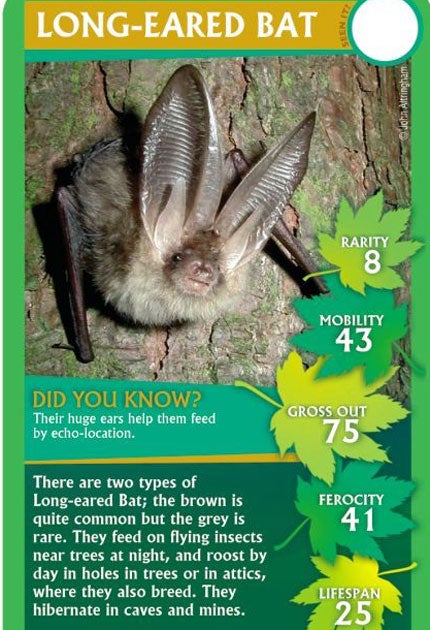Top Trumps: All creatures great and small
Butterflies vs bats. Squirrels vs stag beetles. The natural world is at war – but don't worry, it's all for a good cause. Holly Williams plays a game of wildlife Top Trumps

You're feeling confident. Your card shows the eel. He's a nasty-looking brute – and, as you've just read, he can grow to a slithery 1m long. He has a well-deserved gross out score of 148.
Your first rival has got a dormouse. That's not gross. It's cute, furry, and sleepy, and the card tells you it "hibernates through the winter in a tight ball", giving it a measly gross-out score of two. But your next opponent wields the basking shark. It's certainly ugly, with a huge mouth, even if it does apparently only feed on plankton and "tiny fish". But hey, it's a shark. It wins, with a gross out score of 150.
Trumped!
Pitting these unlikely foes against each other is the National Trust's new version of Top Trumps (£5, Nationaltrust.org.uk/shop), the Eighties playground card game that was revived in 2000, and now comes with an educational spin. It's also a portal to Britain's wildlife. The aim of the game is to make our native creatures interesting and accessible. It's that old learning-through-fun chestnut, and this version of Top Trumps delivers pretty well on both. Thirty cards show a range of creatures, from the attractive and cuddly to the really rather unpleasant. There are points for mobility, ferocity (watch out for those pike), lifespan and rarity, as well as facts and figures about each insect or animal – which hopefully will pique interest in creatures and conservation beyond just a quick card battle.
That's the aim for the National Trust: to get children interested in what and where the wild things are. "It's really important," says Matthew Oates, the NT's nature conservation adviser. "I'm sure it will help raise levels of awareness and interest. But we want to say 'you can learn in a fun way'. A lot of wildlife is fun. Most of the animals we use have curious life cycles, or do amazing things like migrate thousands of miles. We wanted to celebrate the amazing things wildlife gets up to; it really is something we can all enjoy and wonder at.
"We also cover the nasty side of things too. It would be wrong for us to just say 'oh it's pretty'. It's not about beauty, but about appreciating the awe and wonder in nature. A lot have really high gross out scores and significant ferocity levels – even ones you might not expect." The male purple emperor butterfly – which does look rather regal – turns out to "drink juices from nasty things ... especially dog and fox poo". Gross out score: 93.
Oates, who worked with his colleague Lucy Cordey in selecting the 30 animals, explains they also wanted to have a good range, to really boost awareness of creatures a young player might never even have heard of. "The pack contains a mixture of the familiar and the unfamiliar, and actually we only know a lot of these animals remotely. Some things people see everyday, like the blackbird, but then there are creatures you very rarely see." So the natterjack toad (fun fact: it buries itself in damp sand during the day – and all winter long) is likely to trump on rarity.
Unless, that is, you're up against its fellow high scorer, the large blue butterfly. "We wanted to have animals with a conservation message," says Oates. "The large blue butterfly, for instance, was brought back from extinction in Britain. That really does offer hope – it's not all doom and gloom."
So aside from the rarities, how did they choose what went in? "It was a bit of a battle of wills," confesses Oates. "We had to be consistent, but there was quite a bit of debate – at times almost heated – about what animals were included. It wasn't easy.
"I was sad to see some go. It would have been nice to have more insects and invertebrates; it would have been nice to have a snail. But we just had to have a pony, for the horsey girls, and the red squirrel and puffin were absolute musts – people would expect them."
Oates admits he had a personal deal breaker: "I'm going to out myself as a great fan of the purple emperor butterfly. Right at the beginning I said it had to go in. There was a bit of favouritism. But we all have plants and animals of which we are particularly fond, and that's ok."
After a flip through the deck, I'm choosing the otter as my favourite (beating off competition from the red squirrel and the bizarre long-eared bat, whose hilariously huge ears "help it feed by echo-location"). In a stand-off, my otter would take down Oates' butterfly on rarity, ferocity, lifespan – the poor purple emperor only lives for 0.04 years – not to mention mobility, for which the otter gets a slinky 70. The butterfly still wins on the gross out , thanks to that dirty juice habit it's got. Intriguing and informative, the National Trust has come up trumps with this one.
Join our commenting forum
Join thought-provoking conversations, follow other Independent readers and see their replies
Comments
Bookmark popover
Removed from bookmarks